Proverb 18:13 He that answereth a matter before he heareth it, it is folly and shame unto him.
pervert v. /per-vert/ 1 alter from an original meaning or state to a distortion of what was first intended. 2 lead away from what is right, natural, or acceptable.
© South African Pocket Oxford Dictionary, 3rd Edition 2002
 Following on from the recent five part series titled “Pervert Translations and Publishers” which can be found here (please do read each part first if you have not already done so) – Part 1, Part 2, Part 3, Part 4, Part 5 – as well as The Nestle-Aland Greek New Testament Text blog posting; hereunder is a video that lines up with what has been recorded by writer under the inspiration of the Holy Spirit. Scripture tells us to test all things, as we are to be as the Bereans “… in that they received the word with all readiness of mind, and searched the scriptures daily, whether those things were so.” (see Acts 17:11).
Following on from the recent five part series titled “Pervert Translations and Publishers” which can be found here (please do read each part first if you have not already done so) – Part 1, Part 2, Part 3, Part 4, Part 5 – as well as The Nestle-Aland Greek New Testament Text blog posting; hereunder is a video that lines up with what has been recorded by writer under the inspiration of the Holy Spirit. Scripture tells us to test all things, as we are to be as the Bereans “… in that they received the word with all readiness of mind, and searched the scriptures daily, whether those things were so.” (see Acts 17:11).
After viewing this video (or before, depending on your preference) there is some exposing of the modern pervert bibles to be done, which impacts on what they teach, how doctrine is twisted and the blatant contradictions that ultimately will affect what you believe, your faith and your studying of the Holy Scriptures.
As you will see from what follows, I do believe what will be revealed here is under the inspiration of the Holy Spirit. Please understand, and do pray for discernment for our LORD God to open your eyes and do ask for wisdom and understanding. Also know this that if there is any contradictions between Bibles the Holy Spirit will not teach and guide you in all truth in both Bibles as there can only be one Truth! Our Lord and Saviour Jesus Christ said:
John 16:13a Howbeit when he, the Spirit of truth, is come, he will guide you into all truth: … [my emphasis]
John 17:17 Sanctify them through thy truth: thy word is truth.
We will first start off by saying that before the 1611 Authorized King James Bible there were other English translations that preceded the KJB. These were:
-
John Wycliffe New Testament ca.1380 A.D.
-
William Tyndale New Testament ca.1526 A.D.
-
Myles Coverdale Bible 1535 A.D.
-
Matthew Bible 1537 A.D.
-
Great Bible 1539 A.D.
-
Geneva Bible 1560 A.D.
-
Bishops Bible 1568 A.D.
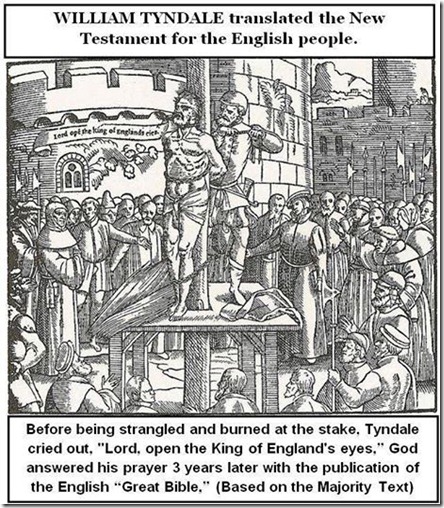 The 1611 Authorized King James Bible in English is the result of the preceding pioneers who stood against the papacy of the Roman Catholic church, and now for 403 years (1611-2014) the KJB has stood the test of time. We will be comparing the King James Bible against – “Today, the better English translations of the Hebrew and Greek Scriptures” according to Dr. John MacArthur at page xxi under subheading Transmission in The MacArthur Study Bible Updated Edition, which he lists as follows:
The 1611 Authorized King James Bible in English is the result of the preceding pioneers who stood against the papacy of the Roman Catholic church, and now for 403 years (1611-2014) the KJB has stood the test of time. We will be comparing the King James Bible against – “Today, the better English translations of the Hebrew and Greek Scriptures” according to Dr. John MacArthur at page xxi under subheading Transmission in The MacArthur Study Bible Updated Edition, which he lists as follows:
-
New American Standard Bible (NASB);
-
English Standard Version (ESV); and
-
New King James Version (NKJV).
These translations as completed bibles have been in circulation for less than half a century from the year of their first printing: NASB 43 years (1971-2014), ESV 13 years (2001-2014) and NKJV 32 years (1982-2014).
Please also bear in mind that the three aforementioned translations that are being used, have also used modernised Greek Texts that have the influence of the two Cambridge professors Westcott and Hort – who not only hated the Textus Receptus calling it vile, but was involved with many heretic beliefs and practices including being members of spiritual clubs. You can also read “Chapter 8: Westcott and Hort” from “Gipp’s Understandable History of the Bible” © 1987 by Samuel C. Gipp). Here is also a short quote from Riplinger:
The Men Who Made Themselves Judges
Westcott and Hort were spiritualists. They sought out contact with the spiritual world (talking with the dead, etc.). Riplinger speaks much on this subject and also aligns them with the New Age movement. They started the “Ghostly Guild” in 1851 and before that the “Hermes Club” in 1845. Riplinger links the spiritualist teachings of Westcott and Hort to the occult teachings of Madame Helena P. Blavatsky who wrote the Lucifer magazine. Westcott, Hort, and Blavatsky are all forerunners of the modern day New Age movement which aims at one world religion.
 The NASB uses the Greek Text, quote from page xxxi in the Foreword to The MacArthur Study Bible Updated Edition: “Consideration was given to the latest available manuscripts with a view to determining the best Greek text. In most instances the 26th edition of Eberhard Nestle’s NOVUM TESTAMENTUM GRAECE was followed.”
The NASB uses the Greek Text, quote from page xxxi in the Foreword to The MacArthur Study Bible Updated Edition: “Consideration was given to the latest available manuscripts with a view to determining the best Greek text. In most instances the 26th edition of Eberhard Nestle’s NOVUM TESTAMENTUM GRAECE was followed.”
The ESV, as quoted from page x in the Preface under Textual Basis and Resources, reads with regards to the Greek text used: “… and on the Greek text in the 1993 editions of the Greek New Testament (4th corrected ed.), published by the United Bible Societies (UBS), and Novum Testamentum Graece (27th ed.), edited by Nestle and Aland. … Similarly, in a few difficult cases in the New Testament, the ESV has followed a Greek text different from the text given preference in the UBS/Nestle-Aland 27th Edition …”
In respect of the NKJV, besides the “much speech” in the Preface at pages v and vi explaining The New Testament Text, writer will quote the following: “There is more manuscript support for the New Testament than for any other body of ancient literature. Over five thousand Greek, eight thousand Latin, and many more manuscripts in other languages attest the integrity of the New Testament. There is only one basic New Testament used by Protestants, Roman Catholics, and Orthodox, by conservatives and liberals. Minor variations in hand copying have appeared through the centuries, before mechanical printing began about A.D. 1450. … In light of these facts, and also because the New King James Version is the fifth revision of a historic document translated from specific Greek texts, the editors decided to retain the traditional text in the body of the New Testament and to indicate major Critical and Majority Text variant readings in the center-column notes of the present edition. It is most important to emphasize that fully eighty-five percent of the New Testament text is the same in the Textus Receptus, the Alexandrian Text, and the Majority Text.” [Writer: This is not a faithful record that the NKJV editors want you to believe. This is the type of marketing hype men will stoop to to sell their product.] You can read more at this link: The Nestle-Aland Greek New Testament Text blog posting.
Now let us look at a few errors (of thousands) that appear in the modern pervert bibles against the inspired and preserved, inerrant and infallible Word of God as contained in the 403 year old King James Bible.
Jehovah
In the modern translations of the Bible we see that the proper Name of God has been removed from the text. In some instances only a shortened version is recorded and most times only His titles are used. The most common name which is rendered God comes from the Hebrew word Elohiym. One of the titles for God is Lord, which is translated from the Hebrew word Adonay. While the Hebrew proper Name of God is known by the four letters YHVH, also known as the Tetragrammaton [from Greek τετραγράμματον, meaning “(consisting of) four letters”] is the Hebrew theonym יהוה (r to l Yodh Hē Vav Hē)(from classical Greek theos “god” and –onym “name”). This is one of the names of the national God of Israel used in the Hebrew Bible. While “Yahweh” is favoured by most Hebrew scholars and is widely accepted as the pronunciation of the Tetragrammaton, Jehovah is the English translation of the Hebrew Name for God, which while it starts with the letter “J”, and many scholars may say there is no “J” in Hebrew, this is where they err. The English translation of the Hebrew word Yᵉhôvâh which starts with a “Y” is translated Jehovah which starts with a “J” in English. Being an English translation you have the English spelling not the Hebrew spelling, for example, like Israel in English and Yisrael in Hebrew. Further, out of reverence the Jews would not take YHVH’s sacred and holy Name upon their lips out of fear of breaking the Third Commandment of taking His Name in vain:
Exodus 20:7 Thou shalt not take the name of the LORD thy God in vain; for the LORD will not hold him guiltless that taketh his name in vain.
Therefore, when Jews read the Torah they use the word Adonay (“Lord”). As a result, God’s Holy Name also is rendered in the English Bibles as LORD. Whilst the modern pervert bibles do explain in their prefaces why the word “LORD” appears, there is also the contention that “Bibles” do not have the proper Name of God in them. This is untrue. The King James Bible has God’s Name recorded as follows:
Exodus 6:3 And I appeared unto Abraham, unto Isaac, and unto Jacob, by the name of God Almighty, but by my name JEHOVAH was I not known to them.
Psalm 83:18 That men may know that thou, whose name alone is JEHOVAH, art the most high over all the earth.
Isaiah 12:2 Behold, God is my salvation; I will trust, and not be afraid: for the LORD JEHOVAH is my strength and my song; he also is become my salvation.
Isaiah 26:4 Trust ye in the LORD for ever: for in the LORD JEHOVAH is everlasting strength:
In The Strong’s Complete Word Study Concordance Expanded Edition, 2004, JEHOVAH is translated from the Hebrew word:
3068 יהוה , Yᵉhôvâh, yeh-ho-vaw’; from 1961; (the) self-Existent or Eternal; Jehovah, Jewish national name of God: – Jehovah, the Lord. Compare 3050, 3069.
A noun meaning God. The word refers to the proper name of the God of Israel, particularly the name by which He revealed Himself to Moses (Ex 6:2,3). The divine name has traditionally not been pronounced, primarily out of respect for its sacredness (cf. Ex 20:7; Dt28:58). Until the Renaissance, it was written without vowels in the Hebrew text of the OT, being rendered as YHWH. However, since that time, the vowels of another word ‘ădônây (136), have been supplied in hopes of reconstructing the pronunciation. Although the exact derivation of the name is uncertain, most scholars agree that its primary meaning should be understood in the context of God’s existence, namely that He is the “I AM THAT I AM” (Ex 3:14), the One who was, who is, and who always will be (cf. Rev 11:17). …
Now let us look at the NASB, ESV and NKJV et al compared to the King James Bible:
KJB – Exodus 6:3 And I appeared unto Abraham, unto Isaac, and unto Jacob, by the name of God Almighty, but by my name JEHOVAH was I not known to them.
NASB – Exodus 6:3 and I appeared to Abraham, Isaac, and Jacob, as God Almighty, but by My name, ²LORD, I did not make Myself known to them.
ESV – Exodus 6:3 I appeared to Abraham, to Isaac, and to Jacob, as God Almighty,² but by my name the LORD I did not make myself known to them.
NKJV – Exodus 6:3 “I appeared to Abraham, to Isaac, and to Jacob, as God Almighty, but by My name LORD¹ I was not known to them.
Whilst each of the above translations exclude the Name of God YEHOVAH from the main body of text, the NASB has a column note “²Heb YHWH, usually rendered LORD.” So why does the NASB rather record a title, for that is what the word LORD or Lord is just that, a title? Therefore, God is named a title, and at the same time doubt is created in the readers’ minds. In the ESV the only footnote on this portion of Scripture is not for LORD, but for God Almighty which reads: “²Hebrew El Shaddai.” It is also noted in the 1982 NKJV by a footnote: “¹Hebrew YHWH, traditionally Jehovah.” So why don’t they say it in the main body of text? So therefore the King James Bible has always been correct for the past 403 years! The ESV just uses a title in this verse.
What is also of great significance is that the punctuation differs greatly from one translation to another, which can alter the manner in which the verses are conveyed. What must also be borne in mind is that whilst the more recent translations have adopted the practice of capitalising the subject, the object, and the possessive pronouns, when referring to God and His Son, it does not make the text more spiritual by this application. It does not appear that there was a hard and fast rule of practice in 17th century English to capitalise subject, object, and possessive pronouns, nouns, or the like, or use quotation marks for speech. However, capital letters are used when referring to Deity of the Godhead – Father, Son and Holy Spirit, and the subject, object, and possessive pronouns can be understood in the context of the verses as read with the whole chapter and specific book of the Bible. The Holy Spirit brings understanding and it is made clear by studying the Scriptures.
Let us now look at the second set of Scriptures:
KJB – Psalm 83:18 That men may know that thou, whose name alone is JEHOVAH, art the most high over all the earth.
NASB – Psalm 83:18 That they may know that You alone, whose name is the LORD, Are the Most High over all the earth.
ESV – Psalm 83:18 that they may know that you alone, whose name is the LORD, are the Most High over all the earth.
NKJV – Psalm 83:18 That they may know that You, whose name alone is the LORD, Are the Most High over all the earth.
No column or footnotes in the pervert translations to quantify or qualify the title LORD. God’s known Name is removed from the Holy Scriptures in the modern versions of this verse. In this particular verse God Almighty is emphatically stating His Name.
In the third set of Scripture:
KJB – Isaiah 12:2 Behold, God is my salvation; I will trust, and not be afraid: for the LORD JEHOVAH is my strength and my song; he also is become my salvation.
NASB – Isaiah 12:2 “Behold, God is my salvation, I will trust and not be afraid; For the LORD GOD is my strength and song, And He has become my salvation.”
ESV – Isaiah 12:2 “Behold, God is my salvation; I will trust, and will not be afraid; for the LORD GOD⁵ is my strength and song, and he has become my salvation.”
NKJV – Isaiah 12:2 Behold, God is my salvation. I will trust and not be afraid; ‘For YAH the LORD, is my strength and song; He also has become my salvation.’”
In the aforementioned translations relating to Isaiah 12:2, the following is evident. The NASB once again has titles with no column notes, but Dr MacArthur attempts to explain LORD GOD in his commentary at page 954 of The MacArthur Study Bible Updated Edition: “The doubling of the personal name of God serves to emphasize His role as the covenant-keeping One.” This is not a faithful interpretation of the verse. The verse is speaking of trust in the One who gives salvation, but more importantly it is referring to the proper Name of God the LORD JEHOVAH (YHVH). The ESV has a footnote: “⁵Hebrew for Yah, the LORD.” The NKJV includes the abbreviated proper Name of YEHOVAH as YAH, which was previously referred to under the Hebrew word 3068 יהוה , Yᵉhôvâh and is the contracted version being the Hebrew word:
3050 יה , Yah, yaw’, contraction for 3068, and meaning the same, Jah, the sacred name – Jah, the Lord, most vehement. Cp. names in “-iah,” “-jah.”
A neuter pronoun of God, a shortened form of Yahweh, often translated “LORD.” This abbreviated noun for Yahweh is used in poetry especially in the Psalms. …
In closing this section, we will look at the fourth portion of Scripture comparisons hereunder:
KJB – Isaiah 26:4 Trust ye in the LORD for ever: for in the LORD JEHOVAH is everlasting strength:
NASB – Isaiah 26:4 Trust in the LORD forever, For in ¹GOD the LORD, we have an everlasting Rock.
ESV – Isaiah 26:4 Trust in the LORD forever, for the LORD GOD is an everlasting rock.
NKJV – Isaiah 26:4 Trust in the LORD forever, For in YAH, the LORD, is ¹everlasting strength.
Here the NASB and NKJV are attempting to quantify and qualify who the LORD is, whilst they do not appear to be sure how to record God’s proper Name. The NASB uses GOD and has a margin note: “¹Heb. YAH, usually rendered LORD.” And the NKJV uses YAH and has a footnote in reference to everlasting strength: “¹Or Rock of Ages.”
It is evident that the NASB, ESV, NKJV, et al have removed God’s proper Name from the main body of text. These versions might have column and footnote references, but ultimately they cause more dissension by creating doubt, division and mistrust as to what is in the Word of God or what is not! The root causes of this is two fold – firstly the deceptive work of Satan the devil and secondly the love of filthy lucre.

Who Killed Goliath?
According to most first graders attending Sunday School, David killed Goliath the Philistine of Gath – and that is what the Authorised King James Bible says, too (see 1 Samuel 17:49,50).
However, according to 2 Samuel 21:19 in the modern pervert translations Elhanan killed Goliath. From the comparisons of the various Scripture translations one can see that the King James Bible has it correct.
KJB – 2 Samuel 21:19 And there was again a battle in Gob with the Philistines, where Elhanan the son of Jaareoregim, a Bethlehemite, slew the brother of Goliath the Gittite, the staff of whose spear was like a weaver’s beam.
NASB – 2 Samuel 21:19 There was war with the Philistines again at Gob, and Elhanan the son of Jaare-oregim, the Bethlehemite, ¹killed ²Goliath the Gittite, the shaft of whose spear was like a weaver’s beam.
ESV – 2 Samuel 21:19 And there was again war with the Philistines at Gob, and Elhanan the son of Jaare-oregim the Bethlehemite killed Goliath the Gittite, the shaft of whose spear was like a weaver’s beam.²
NKJV – 2 Samuel 21:19 Again there was war at Gob with the Philistines, where Elhanan the son of ¹Jaare-Oregim the Bethlehemite killed the brother of Goliath the Gittite, the shaft of whose spear was like a weaver’s beam.
The NASB has the following column notes: “¹Lit smote ²In 1Ch 20:5, Lahmi, the brother of Goliath”. The MacArthur Study Bible Updated Edition at page 452 also records under the commentary the following: “21:19 Elhanan . . . killed Goliath. The minor scribal omission of “the brother of” (in the Heb.) belongs in the verse, based on 1Ch 20:5 which includes them, and because clearly the Scripture says that David killed Goliath as recorded in 1Sa 17:50. There has probably been a scribal error in the text which should read, “Elhanan . . . killed the brother of Goliath.” A second possible solution is that Elhanan and David may be different names for the same person, just as Solomon had another name (cf. 12:24,25). A third solution is that there were two giants named Goliath.” I would agree with MacArthur on the first part of his commentary that the words “the brother of” in italics confirms who was being slew, i.e. Lahmi, but the “second possible solution” cannot be correct. MacArthur is misleading in his suggestion as he is attempting to explain away the incorrect rendering of 1 Samuel 21:19 that has no Biblical foundation. There were two separate events, one where the Philistines were “gathered together at Shochoh, which belongeth to Judah, and pitched between Shochoh and Azekah, in Ephesdammim.” (See 1 Samuel 17:1) In the second account in 2 Samuel 21:19 it reads: “And there was again a battle in Gob with the Philistines …” (my emphasis). This “second battle” in Gob was without David as in 2 Samuel 21:17b it reads: “… Then the men of David sware unto him, saying, Thou shalt go no more out with us to battle, that thou quench not the light of Israel.” The reason? Because “David waxed faint” (see 2 Samuel 21:15). This event preceded the battle at Gob. Also, Elhanan could not be David as Elhanan was the son of Jaare-oregim (Jair) whereas David was the son of Jesse (see 1 Samuel 17:12). Elhanan was one of David’s servants when you read this portion of Scripture in context. MacArthur’s “third possible solution” is also incorrect saying “that there were two giants named Goliath” because when one cross-references 1 Chronicles 20:5 it clearly states that the Philistine slew by Elhanan was named Lahmi the brother of Goliath:
1 Chronicles 20:5 And there was war again with the Philistines; and Elhanan the son of Jair slew Lahmi the brother of Goliath the Gittite, whose spear staff was like a weaver’s beam.
Further, the ESV has a footnote: “²Contrast 1 Chronicles 20:5, which may preserve the original reading.” If it “may preserve the original reading” then which is it? Then why does 2 Samuel 21:19 not read the same as 1 Chronicles 20:5 in the ESV for it creates doubt, for if one reads the 2 Samuel 21:9 account it says Elhanan killed Goliath. The NKJV has a footnote: “¹Jair, 1 Chr. 20:5”. Although the NKJV is the translation that is closest to the King James Bible on this particular issue, it lacks credibility in many other verses. It can be clearly seen that column and footnotes together with commentary notes can be misleading and deceptive.
>> No “New Testament” in the New Testament
Whilst we would agree that the Old Testament in the Bible primarily refers to a covenant between God and Israel and therefore referred to as an Old Covenant, our Lord Jesus Christ established a New Testament in His blood through death, as we read in Hebrews 9:15, as it is written:
Heb 9:15 And for this cause he is the mediator of the new testament, that by means of death, for the redemption of the transgressions that were under the first testament, they which are called might receive the promise of eternal inheritance.
We will compare the Scriptures in the Lord’s Supper and those found in the Book of Hebrews, hereunder. We do note that the modern versions refer to a covenant, but there is no agreement as to whether it is a “covenant” or a “new covenant.”
|
SCRIPTURE VERSE |
KJB (1611/AV) |
NASB |
ESV |
NKJV |
|
Matthew 26:28 |
new testament |
covenant |
² covenant |
¹new covenant |
|
Mark 14:24 |
new testament |
covenant |
¹ covenant |
¹new covenant |
|
Luke 22:20 |
new testament |
new covenant |
new covenant |
new covenant |
|
1 Corinthians 11:25 |
new testament |
new covenant |
new covenant |
new covenant |
|
2 Corinthians 3:6 |
new testament |
new covenant |
new covenant |
new covenant |
|
Hebrews 7:22 |
better testament |
better covenant |
better covenant |
better covenant |
|
Hebrews 9:15 |
new testament |
new covenant |
new covenant |
new covenant |
|
Hebrews 9:15 |
first testament |
first covenant |
first covenant |
first covenant |
|
Hebrews 9:16 |
testament |
¹covenant |
will |
testament |
|
Hebrews 9:17 |
testament |
¹covenant |
will |
testament |
|
Hebrews 9:18 |
first testament |
first covenant |
first covenant |
first covenant |
References in column and footnotes –
NASB – ¹testament
ESV – ² Some manuscripts insert new; ¹ Some manuscripts insert new
NKJV – ¹NU omits new
The problem arises with the use of “covenant” when Hebrews 9:16,17 comes around for it reads as follows in the King James Bible:
Heb 9:16 For where a testament is, there must also of necessity be the death of the testator.
Heb 9:17 For a testament is of force after men are dead: otherwise it is of no strength at all while the testator liveth.
All the pervert modern versions now correct the errors that they have translated as “covenant”. The NASB uses column notes to refer to “testament”; whilst the ESV uses the word “will”; whilst the unfaithful NKJV uses “testament.” The reason why writer has termed the NKJV “unfaithful” is as a result of the translators who had “set out to only correct the so-called archaic words, initially”, ended up performing a translation where whole words, sentence construction and even doctrines have been changed. Interchanging between “new covenant / covenant / testament” is not a faithful translation when reading the verses in context. Has our Lord Jesus Christ established a New Testament? or Covenant? The NKJV is a totally new translation piggy-backing on the name of the King James Bible, copyrighting a new and different bible for filthy lucre’s sake.
For many years, since 1985, writer was employed at the Master of the Supreme Court (now High Court) offices, at Trust Companies and Attorney Firms as an Estate Controller and Paralegal, and he has dealt extensively with deceased estates that include Last Will and Testaments. In all his years (and even to present date as he does some freelance work to support the ministry by the grace of God providing), writer has never come across a covenant that has been written up by a testator / testatrix. It has always been known as a testament. I have also never heard of lawyers reading out the covenant of the deceased to the heirs. It has always been the Will or Testament. You see a Testator is the author of his Testament. Our Lord Jesus Christ is the Author of His Old and New Testaments.
Here are further documents that you should read to get the full picture:
>> Fables And Facts About The King James Bible
Over the past few decades, new Bible translations have been popping up like popcorn. Many strong Christians have stood their ground and continued to believe, read, and study only the Authorized King James Bible. Many others, however, have forsaken the Book that God has used for centuries. Such people have fallen for smooth advertising schemes and have actually started believing that the modern versions are superior to the King James Bible. It’s very sad that most Christians today have not taken time to study the subject thoroughly enough to see what is really happening. [Read more Here]
>> Why Jesus Cannot Use the New King James Version
This is chapter 8 from Which Bible Would Jesus Use? by Jack McElroy, copyright 2013, used with permission. More information about this book can be found on Jack’s website.
Why can’t the Lord choose the ©1982 New King James Version?
If any man will do his will, he shall know of the doctrine, whether it be of God, or whether I speak of myself. (John 7:17) [Read more Here]
>> The Truth About The English SUBStandard Version
THE FRUIT OF THE ESV
The beginning of the ESV was May 1997 with a meeting headed by James Dobson. Dobson was deeply troubled with the gender-inclusive issues within the NIV and TNIV. The results of the meeting was the “proposed” creation of a new version without the new-age, homosexual, gender-inclusive agenda. Surprisingly, the “troubled” group united around the liberal and apostate Revised Standard Version (RSV) of the Bible. Thus the dubious birth of the ESV was conceived. In September 1998, Trinity Evangelical Divinity School professor Wayne Grudem and Crossway President Lane Dennis received the blessing of the ecumenical National Council of Churches to build the ESV upon their 1971 revision of the Revised Standard Version. And thus the ESV came to life. . . [Read more Here]
>> The Attack on the Bible
by Terry Watkins
God has placed a lot of importance upon His words.
Matthew 24:35 reads, “Heaven and earth shall pass away, but my WORDS shall not pass away.”
Psalms 138:2 says, “. . . for thou hast magnified thy WORD above all thy name.”
Psalms 119:89 says, “For ever, O LORD, thy WORD is settled in heaven.”
The spiritual life-blood of the human race is the word of God.
-
It brings salvation: “Being born again, not of corruptible seed, but of incorruptible, by the word of God. . .” (1 Peter 1:23)
-
It produces faith: “. . . faith cometh by hearing, and hearing by the word of God” (Romans 10:17).
-
It produces spiritual growth: “. . .desire the sincere milk of the word, that ye may grow thereby:” (1 Peter 2:2) [Read more Here]
>> Was the KJV inspired or preserved?
Related articles: Inspiration and Translation; Two Lies, The
The following is from Sam Gipp’s The Answer Book.
QUESTION: Is the King James Bible inspired or preserved?
ANSWER: The original autographs were inspired. The King James Bible is those same autographs preserved up to today.
EXPLANATION: The best way to simply describe inspiration and preservation of the Bible is as follows:
Inspiration is when God takes a blank piece of paper (papyrus, vellum, etc.) and uses men to write His words. Preservation is when God takes those words already written and uses men to preserve them to today. Both of these actions are DIVINE and are assured by God as recorded in Psalm 12:6,7.
6 “The words of the LORD are pure words: as silver tried in a furnace of earth, purified seven times.
7 Thou shalt keep them, O LORD, thou shalt preserve them from this generation for ever.”
In Psalm 12:6 God assures us that His originals are perfect. Even though penned by fallible men with the heinous sins of: murder (Moses and David), adultery (David), idolatry (Solomon), and denial of the Lord (Peter). God’s words are untainted by the sins of the penmen.
That the originals were inspired perfect in their entirety is an undisputed belief among fundamentalists today. [Read more Here]
We conclude with the following statement –
“I must under God denounce every attachment to the New American Standard Version. I’m afraid I’m in trouble with the Lord … We laid the groundwork; I wrote the format; I helped interview some of the translators; I sat with the translator; I wrote the preface. When you see the preface to the New American Standard, those are my words … it’s wrong, it’s terribly wrong; it’s frightfully wrong … I’m in trouble; … I can no longer ignore these criticisms I am hearing and I can’t refute them. The deletions are absolutely frightening … there are so many. The finest leaders that we have today haven’t gone into it [new versions of Wescott and Hort’s corrupted Greek text] just as I hadn’t gone into it … that’s how easily one can be deceived … Are we so naive that we do not suspect Satanic deception in all of this?”
Dr. Frank Logsdon
Co-founder, New American Standard Version
>> Logsdon’s Pro KJV Anti NASV – Download MP3
“Frank Logsdon was a major player in the development of the New American Standard Bible (NASB). He was a friend of Dewey Lockman, and was involved in a feasibility study involving purchasing the copyright of the American Standard Version (ASV) with Lockman that lead to the eventual production of the NASB. He interviewed some of the translators for the job, and even wrote the preface to the translation.
“Slowly, he became aware that there was something wrong with the NASB. He eventually rejected it, and promoted the KJV. This was a major defection for the modern version crowd.
“Below is his speech, in it’s entirety, rejecting the NASB, and endorsing the Textus Receptus and the KJV. (The complete transcript is available here)” ~ quoted from the website www. defendproclaimthefaith.org
If you do not believe that God has inspired and preserved His Word in an English Bible then that leaves you as a bible agnostic!
SOLI DEO GLORIA!
Filed under: Doctrine, Doctrine of Devils, ESV, God's Holy Word, Greek New Testament Text, Holy Bible, Holy Scriptures, John MacArthur, King James Bible, NASB, New Agers, NIV, NKJV, NLT, Pagan, Pervert, Publishers, RSV, The Bible, The Message, The Word, Theology, Translations, Videos, Westcott & Hort | 5 Comments »


















 This blog posting which follows on from Part 1, will deal with two videos that reveal the correct teaching pertaining to Easter being included in Acts 12:4 as opposed to Passover. Each video will also have a link to the text of each video for your study purposes.
This blog posting which follows on from Part 1, will deal with two videos that reveal the correct teaching pertaining to Easter being included in Acts 12:4 as opposed to Passover. Each video will also have a link to the text of each video for your study purposes.


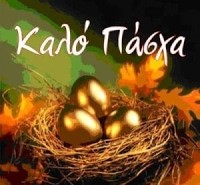 Eggs and bunnies are fertility symbols and as such they can be considered pagan symbols. When Christians brought the celebration of the Lord’s resurrection to pagan nations, these symbols of spring became associated with the Christian celebration of Easter which happens in spring. Spring fertility festivals have ancient origins, and some of their practices are described in the Bible in passages such as Ezekiel 8:14-16 and Jeremiah 7:18 & 44:17-19. There are Christians today who avoid using the word “Easter” for fear that it necessarily refers to these pagan symbols and practices. However, the fact that our culture has come to associate fertility symbols with the name “Easter” does not mean that “Easter” itself is pagan. As with the word “Easter”, even the Greek word “Pascha” has become associated with pagan fertility symbols in present day Greece because “Pascha” is the Greek word for “Easter” (this will be explained in the next section of this article). Yet nobody in his right mind would advise Christians against using the word “Pascha”. Somehow the prejudice against the word “Easter” has become so strong among some Christians that logic no longer holds sway. Guilt by association is a logical fallacy. Moreover this logical fallacy is not applied consistently towards the word “Pascha”. Christians would be wise to purge Easter of its pagan symbols, but the word “Easter” itself remains a biblical word.
Eggs and bunnies are fertility symbols and as such they can be considered pagan symbols. When Christians brought the celebration of the Lord’s resurrection to pagan nations, these symbols of spring became associated with the Christian celebration of Easter which happens in spring. Spring fertility festivals have ancient origins, and some of their practices are described in the Bible in passages such as Ezekiel 8:14-16 and Jeremiah 7:18 & 44:17-19. There are Christians today who avoid using the word “Easter” for fear that it necessarily refers to these pagan symbols and practices. However, the fact that our culture has come to associate fertility symbols with the name “Easter” does not mean that “Easter” itself is pagan. As with the word “Easter”, even the Greek word “Pascha” has become associated with pagan fertility symbols in present day Greece because “Pascha” is the Greek word for “Easter” (this will be explained in the next section of this article). Yet nobody in his right mind would advise Christians against using the word “Pascha”. Somehow the prejudice against the word “Easter” has become so strong among some Christians that logic no longer holds sway. Guilt by association is a logical fallacy. Moreover this logical fallacy is not applied consistently towards the word “Pascha”. Christians would be wise to purge Easter of its pagan symbols, but the word “Easter” itself remains a biblical word.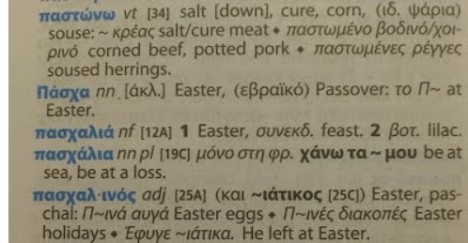
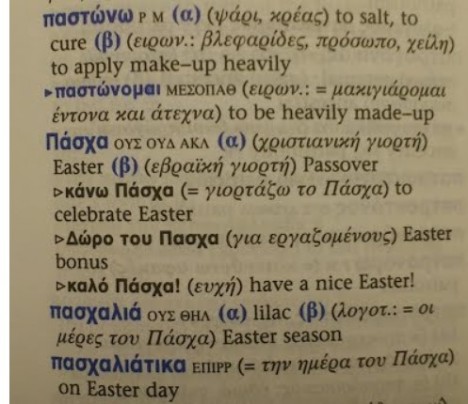
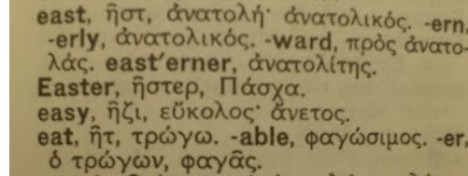
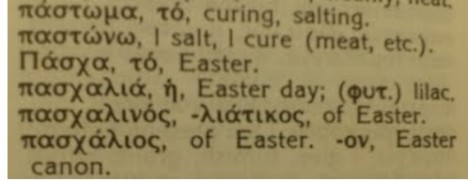
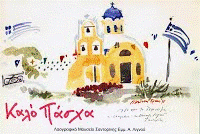
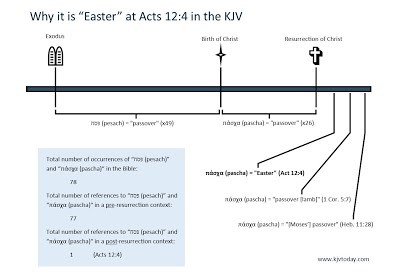

 Thomas Nelson Publishers (publishers of the NKJV) claim, on the inside-cover, the symbol, “… is an ancient symbol for the Trinity.” But Acts 17:29, clearly FORBIDS such symbology: “… we ought NOT to think that the Godhead is like unto gold, or silver, or stone, GRAVEN BY ART and man’s device.”
Thomas Nelson Publishers (publishers of the NKJV) claim, on the inside-cover, the symbol, “… is an ancient symbol for the Trinity.” But Acts 17:29, clearly FORBIDS such symbology: “… we ought NOT to think that the Godhead is like unto gold, or silver, or stone, GRAVEN BY ART and man’s device.”  And why does The Aquarian Conspiracy, a key New Age “handbook”, bear a similar symbol? New Agers freely admit it represents three inter-woven “6”s or “666”.
And why does The Aquarian Conspiracy, a key New Age “handbook”, bear a similar symbol? New Agers freely admit it represents three inter-woven “6”s or “666”.  The three esoteric “6”‘s separated.
The three esoteric “6”‘s separated. Transpersonal Psychology (ITP). The ITP is a new age school following the Jungian Psychology [occultist Carl Jung]. One of their stated goals is “… to reach the recognition of divinity within” (www.itp.edu/about/tp.html) (see Genesis 3:5, “…ye shall be as gods …”)
Transpersonal Psychology (ITP). The ITP is a new age school following the Jungian Psychology [occultist Carl Jung]. One of their stated goals is “… to reach the recognition of divinity within” (www.itp.edu/about/tp.html) (see Genesis 3:5, “…ye shall be as gods …”)  The same symbol (with a circle) is displayed by the rock group Led Zeppelin. Members of Led Zeppelin are deeply involved in satanism and the occult. Guitarist Jimmy Page, so consumed with satanism, actually purchased satanist Aleister Crowley’s mansion. Most believe the symbol is from the teachings of Aleister Crowley and represents 666.
The same symbol (with a circle) is displayed by the rock group Led Zeppelin. Members of Led Zeppelin are deeply involved in satanism and the occult. Guitarist Jimmy Page, so consumed with satanism, actually purchased satanist Aleister Crowley’s mansion. Most believe the symbol is from the teachings of Aleister Crowley and represents 666.  The following picture is “The Hierophant” taken from the Tarot card set designed by satanist Aliester Crowley. The “Hierophant” is a priest in the occult and Eleusinian. Notice the “three circles” at the top of the wand or rod in the Hierphant’s hand. Inside the the three intertwined circles is the “NKJV symbol”.
The following picture is “The Hierophant” taken from the Tarot card set designed by satanist Aliester Crowley. The “Hierophant” is a priest in the occult and Eleusinian. Notice the “three circles” at the top of the wand or rod in the Hierphant’s hand. Inside the the three intertwined circles is the “NKJV symbol”.  To the left is the top of the wand enlarged. Notice the “NKJV symbol” (upside down) inside the three circles.
To the left is the top of the wand enlarged. Notice the “NKJV symbol” (upside down) inside the three circles.  One of the most occultic television shows ever aired is “Charmed”. “Charmed” details the spells and occultic practices of three witches. The “NKJV symbol” is the show’s primary symbol of witchcraft and is splattered throughout the series. Notice the “NKJV symbol” displayed on “The Book of Shadows”. The Book of Shadows is commonly used in witchcraft and satanism:
One of the most occultic television shows ever aired is “Charmed”. “Charmed” details the spells and occultic practices of three witches. The “NKJV symbol” is the show’s primary symbol of witchcraft and is splattered throughout the series. Notice the “NKJV symbol” displayed on “The Book of Shadows”. The Book of Shadows is commonly used in witchcraft and satanism: 
 Here’s some examples of Satanic and Pagan Jewellery which includes the NKJV logo.
Here’s some examples of Satanic and Pagan Jewellery which includes the NKJV logo.
 LEFT: The image on the left is from the rock group Deicide’s album “Once Upon the Cross”. It is a triquetra (the NKJV logo) with pentagrams and upside down crosses. The group Deicide members are very serious Satanists. Lead Singer Glen Benton has an upside down cross branded on his forehead. The inside cover of the album “Once Upon the Cross” has the Lord Jesus Christ, sliced up the middle, with his insides removed. The name Deicide means the death of God.
LEFT: The image on the left is from the rock group Deicide’s album “Once Upon the Cross”. It is a triquetra (the NKJV logo) with pentagrams and upside down crosses. The group Deicide members are very serious Satanists. Lead Singer Glen Benton has an upside down cross branded on his forehead. The inside cover of the album “Once Upon the Cross” has the Lord Jesus Christ, sliced up the middle, with his insides removed. The name Deicide means the death of God.  RIGHT: The triquetra (the NKJV logo) is also the logo for the Rap / Metal band P.O.D.
RIGHT: The triquetra (the NKJV logo) is also the logo for the Rap / Metal band P.O.D. 



 Joshua Project
Joshua Project The Biblical Basis of Missions
The Biblical Basis of Missions

![The Biblical Nativity (Birth) of our Lord Jesus Christ according to the Holy Scriptures in the Gospel of Luke 1 & 2 [see Purge the leaven … blog post] The Nativity of our Lord Jesus Christ ~ Luke 1 & 2 The Biblical Nativity (Birth) of our Lord Jesus Christ according to the Holy Scriptures in the Gospel of Luke 1 & 2 [see Purge the leaven … blog post]](https://luke923evangelism.files.wordpress.com/2012/12/birth-of-christ-e1374168223523.png)



